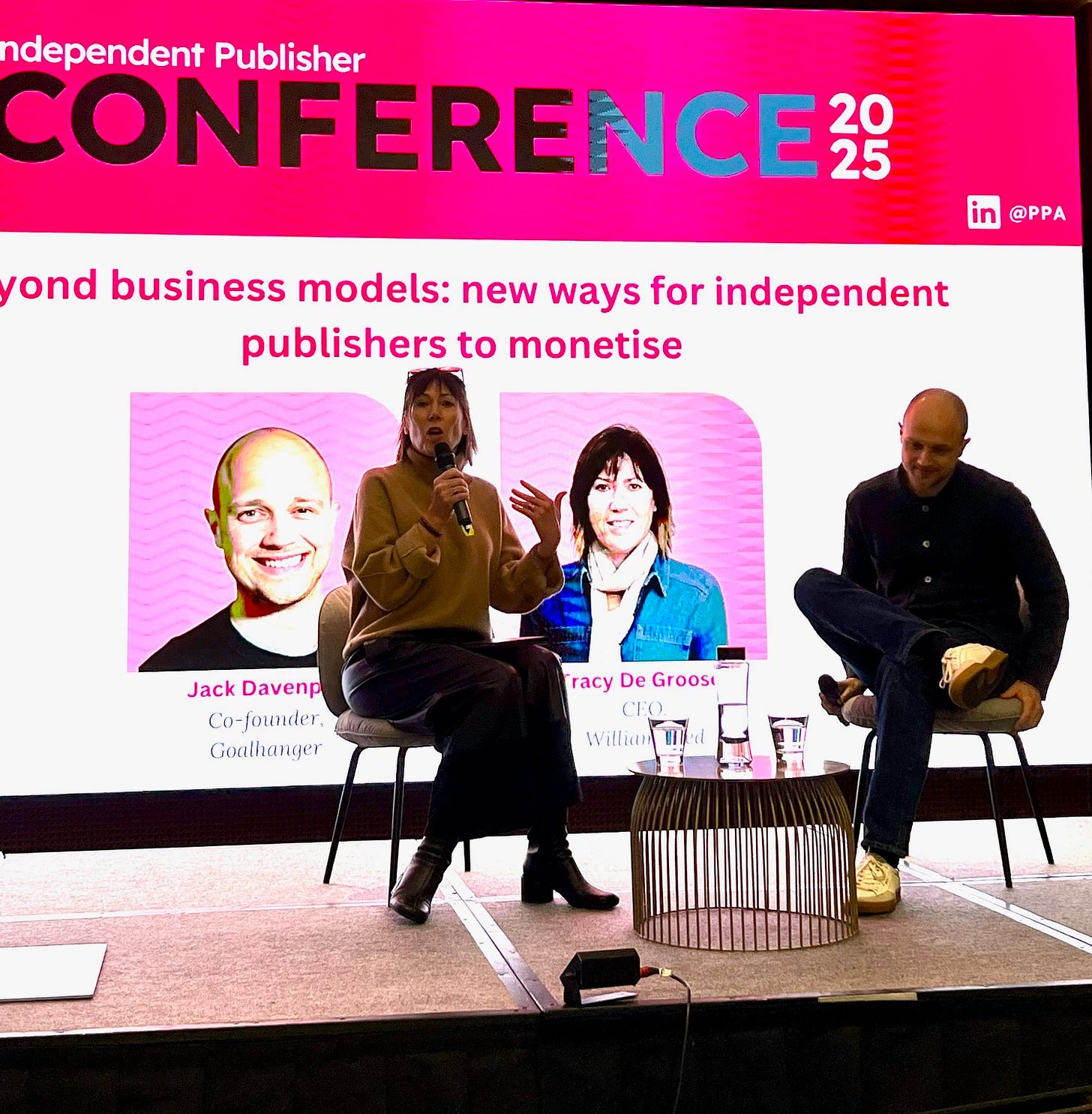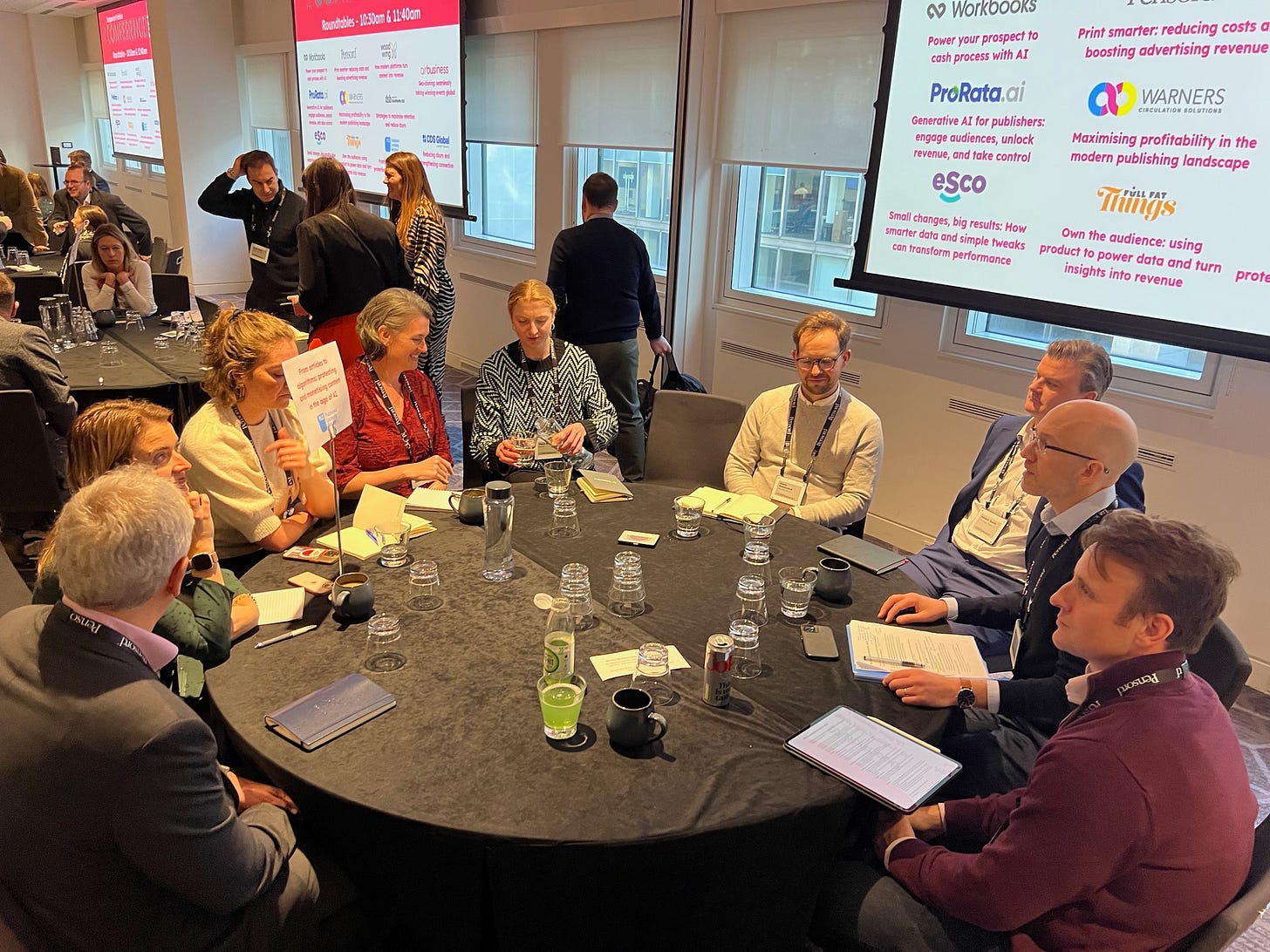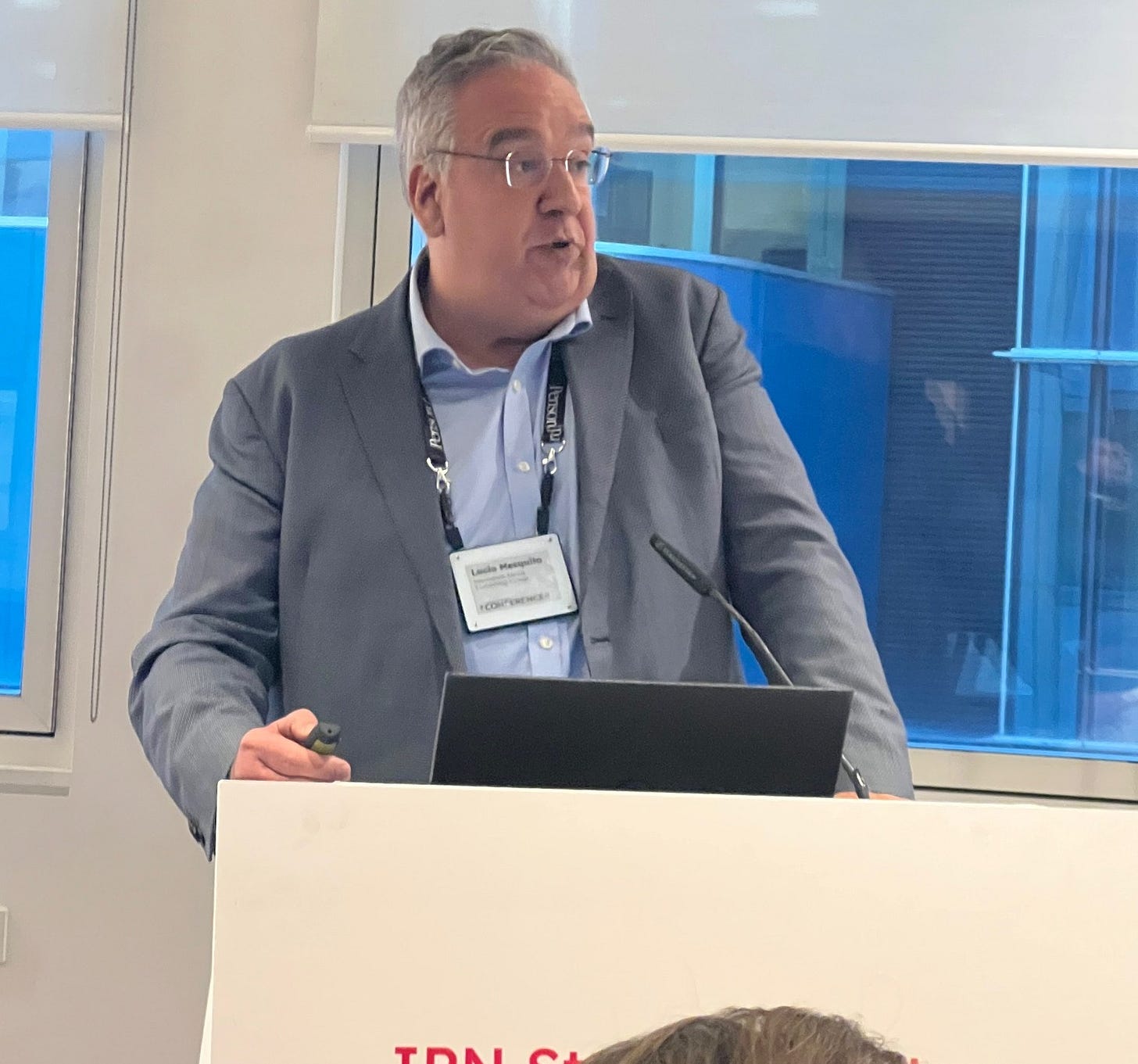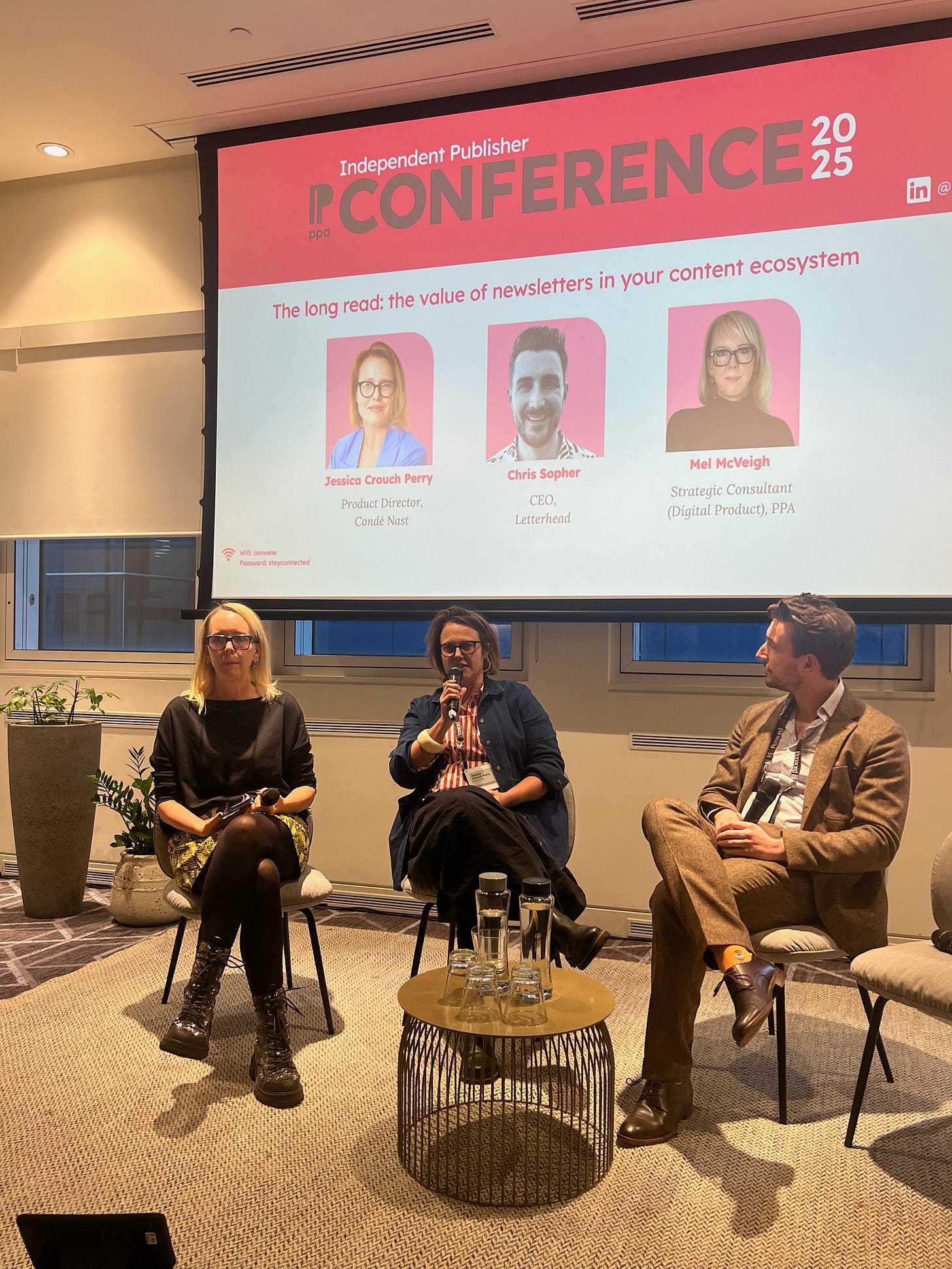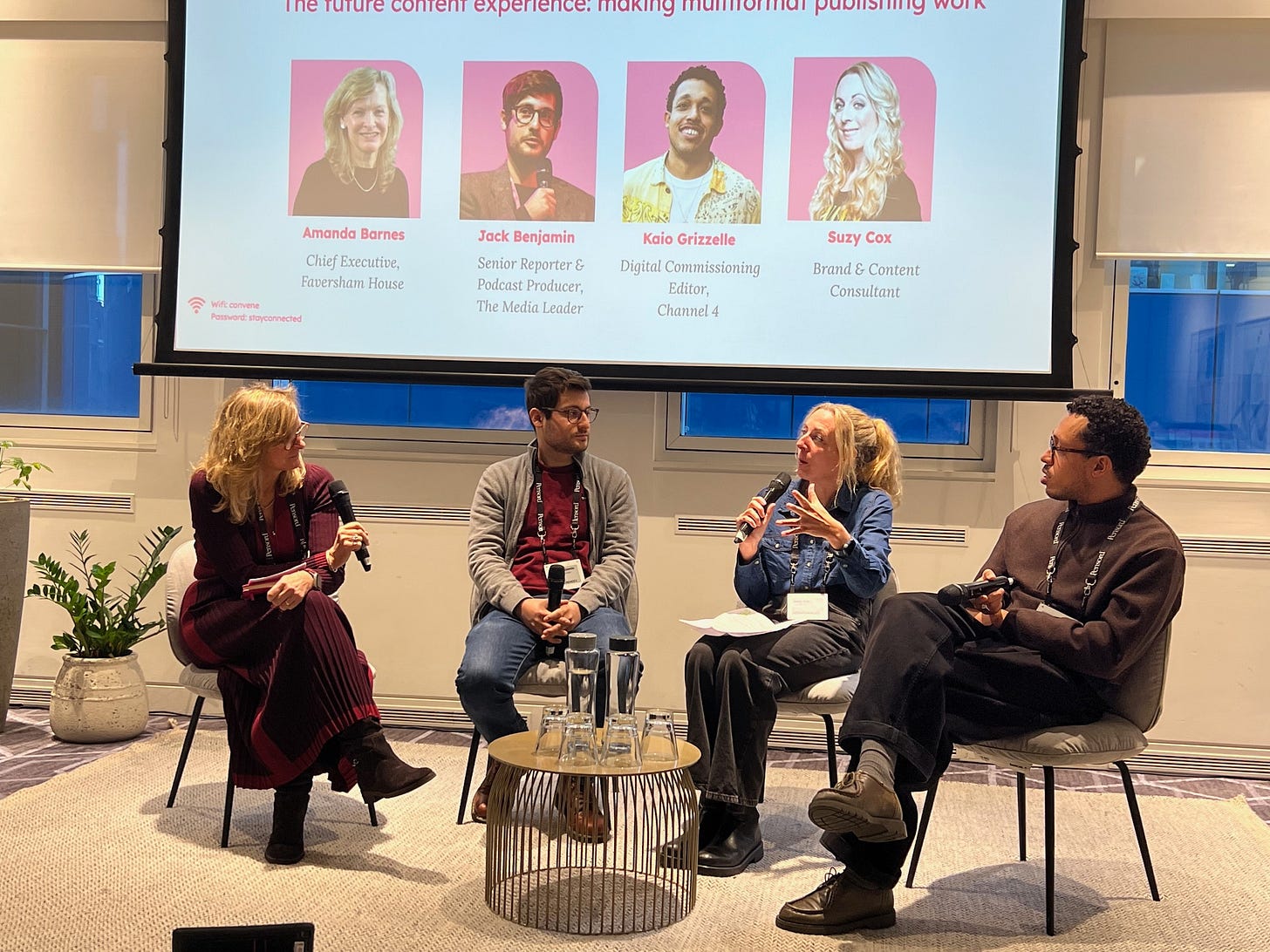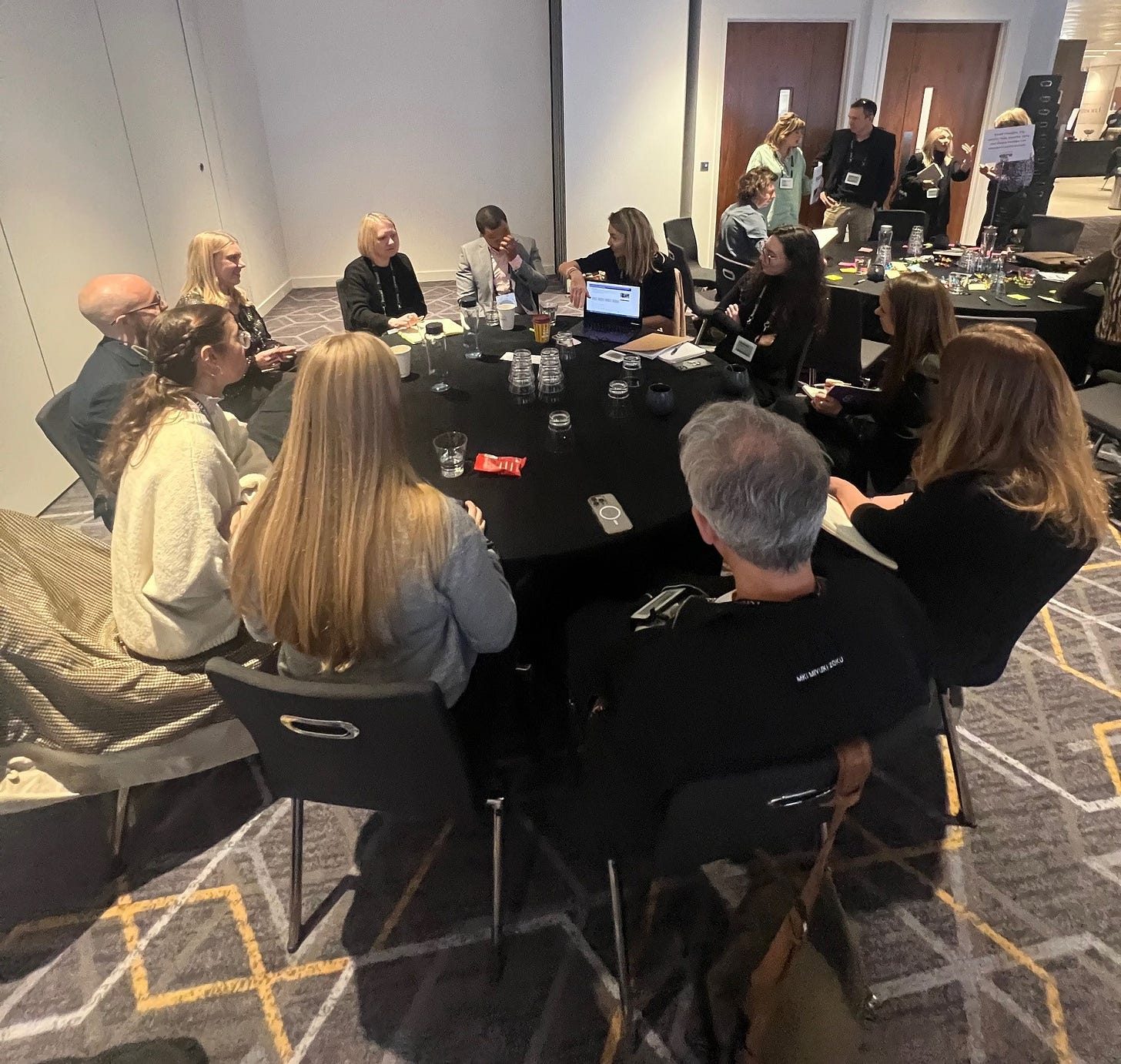Email Over Social, Licensing Over Free Content: The PPA Conference Playbook - Overview of the PPA Independent Publisher Conference, 21 November 2025
AI is eating publisher traffic, but companies like Goalhanger, Condé Nast and Black Business Magazine are thriving anyway. Here's what they're doing differently
AI-driven search traffic is down sharply, with publishers losing up to 30% of their audience to AI tools. While Goalhanger built a 40-million-member community, Condé Nast receives more email than social traffic, and Black Business Magazine now relies on partnerships rather than ads. The conference message: AI poses a threat to traffic, but publishers can adapt with new strategies.
Read time - 10 minutes
Goalhanger: We Don’t Chase Headlines
Jack Davenport, Co-founder of the podcast company, Goalhanger and Tracy De Groose, CEO at William Reed opened by critiquing digital media’s focus on algorithms, superficial content, and uniformity. Goalhanger’s success stems from rejecting these trends and building a podcast network based on distinct values.
Goalhanger does not chase sensational headlines; instead, it focuses on shaping the overall narrative. The team crafts compelling stories designed to keep audiences engaged and invested. By building anticipation and maintaining engagement, they create moments that resonate with listeners.
The Bond reference—comparing our approach to crafting a suspenseful narrative, similar to how a James Bond film builds tension and anticipation resonated with me. In a Bond story, every element is carefully placed to keep the audience invested until the reveal. Craft matters, every word is intentional, pacing builds anticipation, and audiences seek more. This approach contrasts sharply with the headline-driven, algorithm-optimised content prevalent in digital media.
Goalhanger’s community includes 40 million people. This reflects active participation through unique content and credible voices in politics, entertainment, and history.
Culture is now available on demand. We produce films, innovate in animation, and influence how millions think and engage with media.
Their business model includes podcasts, subscriptions, ads, video, events, and direct partnerships. Multiple revenue streams matter, but the foundation is ambitious storytelling that drives engagement. This shift moves the industry beyond Facebook’s algorithm.
The Traffic Problem Everyone’s Seeing
David Buttle, former head of public policy and platform strategy at the Financial Times, which included their OpenAI partnership, now leads his own consultancy. He presented the conference’s most concerning data during one of the round tables.
ChatGPT is growing three times faster than the early internet. Google’s launch of competing AI features is already reducing publisher traffic. Rapid AI competition is outpacing publishers’ ability to adapt.
Around 5 to 8 per cent of my traffic now comes from ChatGPT, Claude, and Perplexity. These platforms currently do not offer monetisation opportunities and frequently use publisher content without compensation.
A B2B publisher shared that 5-8% of traffic now comes from ChatGPT, Claude, and Perplexity, which do not monetise because they scrape content. Early adopters grow more; late adopters plateau. When ChatGPT added real-time web access, usage rose across the board.
These tools supplement Google search, threatening the search traffic on which digital publishing has depended for two decades.
Lucio Mesquita said generative AI is replacing site visits, signalling a decline in traditional internet use. Traditional search focused on ranking, while generative searches give direct answers, changing everything.
Make Them Pay For It
Lucio Mesquita a Senior Consultant at the Innovation Media Consulting Group advice: treat AI companies as you should have treated Google 15 years ago. Don’t repeat past mistakes.
If AI companies use your work, demand compensation, brand credit, and attribution. Make these non-negotiable in every deal.
To turn this principle into practice, publishers can take the following immediate steps:
Evaluate Current Licensing Agreements: Begin by reviewing existing agreements with AI platforms to understand if your content is currently being used and how. Knowing where you stand is critical for negotiation.
Work with other publishers in collective licensing groups. Shared resources and bargaining power can get better terms with AI companies.
Create a clear licensing framework for AI companies. Include terms for payment, attribution, and usage so your content is protected and monetised.
Small publishers should unite for collective licensing. With links mattering less as users get direct answers, attribution supports branding and licensing leverage. The music industry’s collective model is a template for publishers to strengthen positions against large AI firms.
Industry frustration continues as companies like Axel Springer and News International secure individual deals with OpenAI. The music industry took collective action in response to Napster, while publishing has yet to follow suit, leaving smaller publishers susceptible to the unauthorised use of their content.
Mesquita said AI needs high-quality training data, such as academic content and edited journalism. Publishers should collaborate and not provide content without licensing.
What AI Can’t Do
Despite concerns about AI, speakers repeatedly emphasised what it cannot replace. Machines generate words, but journalists create meaning. AI may produce many answers, but journalists ask the essential questions.
Robots do not contact sources. AI cannot gather quotes in person or conduct on-the-ground reporting. As long as these tasks remain beyond AI’s reach, journalists retain a unique role.
This shift requires newsrooms to act as talent agencies, turning journalists and editors into personal brands. The Financial Times and The Economist now highlight journalists’ personalities. Newsletters from named authors have led to up to 15% increases in sign-ups, underlining the value of recognisable journalists within each niche.
While AI can scale content, publishers should focus on fostering human connection. Retaining human-led and controlled content offers audiences unique value that AI cannot provide.
Email Beats Social (Finally)
Jessica Crouch, Product Director of Email at Condé Nast, noted that newsletter traffic now surpasses social media traffic. Titles like The New Yorker, Vogue, Wired, and GQ receive more visits from email than Facebook, Instagram, or Twitter combined. Email subscribers also exhibit higher long-term engagement and retention than social media users. They contribute up to 50% more revenue over their lifecycles, underscoring the strategic value of email as a business channel.
Newsletters drive subscriptions, advertising, and commerce at Condé. Newsletter readers are 4.5 times more likely to subscribe, and 20% of New Yorker trial subscriptions come from editorial newsletters. Newsletters are also the top source of traffic to commerce pages.
Crouch sees newsletters as strategic products, not just marketing tools. Each should have a business goal: driving commerce, encouraging subscriptions, or supporting retention.
Wired recently introduced subscriber-only newsletters, directly competing with platforms like Substack by providing curated expertise from the brand. This approach has produced measurable improvements in retention.
Chris Sopher, CEO of Letterhead, echoed this: more newsletters work if users manage subscriptions. Do not force a single product. Give users distinct voices, topics, and formats so they control their engagement.
Video: No One Actually Knows How Algorithms Work
Amanda Barnes, CEO of Faversham House and a former Channel 4 executive, shared a practical video session. She launched Channel 4.0, the company’s first digital brand, and commissioned entertainment for YouTube. Her take on algorithms was refreshingly blunt.
No one within the organisation fully understands how the algorithms function. If someone claims to have a guaranteed video strategy, they are not being truthful.
Engagement, especially viewing duration, is key. Platforms test content with small audiences and amplify what performs. The first three seconds must capture viewers’ attention to prevent them from leaving.
Start with dynamic moments, pose questions, and create tension to align with platform economics—not by chasing secret formulas.
Barnes emphasised the importance of data-driven decision-making. Publishers can identify when audiences disengage, which thumbnails generate clicks, and which moments cause friction. Channel 4.0 commissioned over 25 production companies, collaborated with more than 100 talents, and continuously refined content based on feedback.
The result was over one million YouTube subscribers, with a million young people engaging with Channel 4 who previously did not watch linear television. Diversification, including maintaining linear channels, remains important to the business.
Her advice is to recognise that TikTok, Instagram, LinkedIn, and YouTube each require distinct strategies. Assign a platform specialist within the team. Prioritise authenticity over perfection, test rigorously, and be prepared to learn quickly from failures.
The 80-20 Model
Justice Williams MBE, co-founder of Black Business Magazine, presented a notably innovative business model. Her recommendation is to stop pursuing advertisers altogether. Williams launched her first magazine 16 years ago, but the advertising-dependent model failed in 2008, leaving her to recover for over 15 years. For Black Business Magazine, she developed a new approach: 80 per cent of revenue comes from strategic brand partnerships, with only 20 per cent from traditional advertising and subscriptions.
Embracing this 80-20 shift carried potential risks, particularly the possibility of losing financial stability without traditional advertisers. However, Williams mitigated this risk by carefully selecting brand partners who align closely with her magazine’s mission and values. By doing so, she not only ensured a stable revenue stream but also strengthened the magazine’s brand identity. This approach highlights the trade-off between reducing dependency on traditional advertisers and securing committed partnerships, making the model feel both innovative and attainable.
We chose not to pursue advertisers. Observing influencers, we recognised the importance of relationships. What if 80 per cent of revenue could come from just 20 per cent of clients?
This model applies influencer economics to publishing: build audience and reputation, then establish partnerships with brands that support the vision. Lloyds Bank serves as their primary partner, acting as a strategic ally rather than a traditional advertiser.
Twelve brand partnerships cover all operational costs before considering traditional revenue. Brands receive authentic access, introductions, and direct relationships, while publishers secure sustainable funding. This shifts the dynamic from vendor-advertiser to true partnership.
Using AI Without Getting Used
The discussion on AI deployment was more nuanced than anticipated. The Argentine newspaper Clarín’s ‘Walter CMS platform similar to other platforms such as Purple, favoured by many German based publishers was cited as a positive example: it generates summaries, glossaries, key takeaways, and data points that complement, rather than replace, human-written stories.
This approach enables ‘doing more with the same’ rather than ‘doing the same with less.’ AI is used for variation, personalisation, and enhanced reader service without replacing journalists. For instance, these platforms have been reported to increase newsroom productivity by up to 20%, as it allows journalists to focus on more in-depth reporting while AI handles routine summaries and data gathering. Some publishers have integrated AI search into their sites, allowing readers to query archives while maintaining subscription requirements for full articles.
However, adoption remains uneven. Several publishers reported slow uptake among editorial teams, especially in sectors such as theatre and books, where journalists are sceptical. The technology also challenges business models that depend on limited page views and advertising impressions.
Can AI half my newsroom? But then what? You have a newsroom that just does what everybody else does, because everybody will be doing that with AI.
That statement summarises the issue: AI should not be used to replace staff for cost savings, but to amplify the unique qualities of your journalism.
What Actually Matters Now
After the morning sessions, several key points emerged. License content aggressively and collectively, as AI companies require quality journalism and publishers gain leverage by acting together. Build human connection and develop journalist personalities, as authenticity outperforms algorithm optimisation. Diversify revenue beyond advertising and subscriptions; Williams’ 80-20 model demonstrates that alternatives are effective.
Maintain direct audience relationships through email, as Condé Nast’s transition from social to email indicates future trends. Use AI to enhance, not replace, editorial work—employ it for summaries, personalisation, and efficiency while retaining editorial control. Recognise that each platform requires a tailored strategy rather than a universal approach.
Test rigorously and be willing to learn quickly from failures. Digital platforms enable rapid iteration, which is not possible in print. Use data extensively, experiment with formats, discontinue ineffective approaches, and scale successful ones. For instance, implement a ‘24-hour test’ framework: Identify a specific change or new approach to try, execute it for one day, collect data on its performance, and evaluate the results. If successful, consider scaling; if not, analyse the data to understand the failure and adjust accordingly. This structured experimentation can accelerate learning and innovation.
Stop Playing by Old Rules
The conference did not provide simple solutions, but it did offer clear direction. Adopt the mantra ‘Own the Relationship’ as the guiding principle. Do not provide content to AI companies without compensation. ‘Own the Relationship’ by building direct audience connections through email and owned channels. Use AI to improve efficiency while maintaining editorial control. Diversify business models beyond traditional advertising. Develop journalist personalities as unique assets. Consistently, ‘Own the Relationship’ serves as the galvanising mantra, anchoring collective action and strategic focus for all publishers.
Most importantly, remember what AI cannot do: gather stories in person, persistently contact sources, ask meaningful questions, create context, and build communities rather than simply pursuing clicks.
Algorithms promote passive consumption and continuous engagement. Publishers must offer an alternative: active thinking, meaningful connections, curated expertise, and compelling stories.
In one of the roundtable discussions, one publisher captured the tension: ‘Yesterday I was doing interviews about AI. The problem is there’s no way to monetise scraping, so you either fight back or turn it to your advantage. But you can only turn it to your advantage if you’re focusing on direct relationships and proving your content is legitimate.’
In summary, publishers must resist content extraction as they develop new business models. Protect content while experimenting with AI, and uphold editorial values while pursuing commercial innovation. The key question is not whether traditional media will survive, but whether publishers can act collectively and swiftly enough to shape the future rather than be shaped by it.
To create immediate momentum, within a week, publishers should form or join collective bargaining groups to negotiate fair compensation and licensing terms with AI companies. This first collective step will lay the groundwork for stronger, unified actions moving forward.
The necessary tools are available, and the conference provided a clear roadmap. Effective implementation is essential, and time is limited. Beyond the Algorithm: How Publishers Are Fighting Back.



